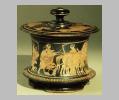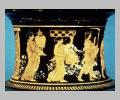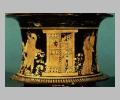[Image not available]
Three-dimensional approximation of the vase

Overview: pyxis with lid

Wedding procession: women bearing vases and chest, man bearing torch

Wedding procession: bride and groom in chariot

Wedding procession: half-open door with woman
| Collection: | London, British Museum |
| Summary: | Wedding Procession. Lid: Helios, Selene and Nyx. |
| Ware: | Attic Red Figure |
| Painter: | Attributed to the Marlay Painter; Lid Painter |
| Context: | Said to be from Greece |
| Date: | ca. 450 BC - ca. 400 BC |
| Dimensions: | H 12.5; H with lid 17.2; D at rim 12.4; D of lid 17.6 |
| Primary Citation: | ARV2, 1277.23; 1282.1; 1689 |
| Shape: | Pyxis |
| Beazley Number: | 216210 |
| Region: | Greece |
| Period: | Classical |
Condition:
The pyxis is in good condition. The surface is somewhat worn.
Decoration Description:
Body: wedding procession. A wedding procession moves to the right, away from the bride's home, represented by a double door. One of the double doors is ajar, as a maid in a simple chiton peeks out to watch the departure of the procession. The bride and groom in their four horse chariot are the focal point of the scene. The bride stands in the chariot, her mantle draped over her head, one edge of it held in her right hand. The groom holds the reins with both hands and leans into the chariot on his left knee, his right foot still on the ground. He wears a short mantle and a wreath over his hair. Standing on the further side of the horses and facing the couple, is a woman holding a torch, dressed in a chiton and himation with a fillet over her hair. A young male wearing a wreath and a mantle walks behind the chariot, a burning torch held in his left hand as he gestures with his right. He is followed by a young woman balancing on her head a flat, square box with a checkerboard design, perhaps containing part of the bride's trousseau. In her other hand she holds a misshapen bundle, possibly other articles of costume or toilet. She wears a simple chiton and a fillet. The young woman behind her carries a large lebes gamikos and is dressed in a chiton and himation, her hair bound with a fillet. The procession is led by a male figure (the groomsman or herald) in chlamys, wreath and sandals, a petasos hanging down his back. He leads the horses with his right hand and looks back at the couple. With his other hand he gestures toward the door, which functions at this end as the groom's home, the destination of the procession.
Lid: Helios, Selene and Nyx. The figures move in a circle to the right. Helios is apparently driving a four horse chariot, although his legs are shown only from mid-thigh up and the chariot is therefore are not shown. Helios, carrying a stick or staff in his left hand, wears a short piece of fabric draped to fall over his left shoulder, cross his chest and wrap under his right arm. It flies behind him to indicate speed. Selene stands in front of a horse facing forward, her head turned to the left and her arms raised in the orans position. She wears a chiton and himation, and her hair is wrapped in a sakkos. Nyx drives a two-horse chariot, her arms held forward to grip the reins. She wears a simple chiton and sakkos.
Shape Description:
Type A pyxis.
Collection History:
The pyxis was bought by the museum at a Sotheby's sale in December 1920.
Sources Used:
Other Bibliography: